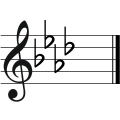A-flat major facts for kids
 |
||
| Relative key | F minor | |
|---|---|---|
| Parallel key | A♭ minor | |
| Notes in this scale | ||
| A♭, B♭, C, D♭, E♭, F, G, A♭ | ||
A♭ major or A-flat major is a major scale that starts on A-flat.
Its relative minor is F minor and its parallel minor is A-flat minor.
This is a very peaceful key. It was used often by Franz Schubert. Twenty-four of Frédéric Chopin's piano pieces are in A-flat major, more than any other key.
Charles-Marie Widor considered A-flat major to be the second best key for flute music.
Beethoven chose A-flat major as the key of the slow movement for most of his C minor works. This was also followed by Antonín Dvořák in his only C minor symphony and Anton Bruckner in his first two C minor symphonies. Since A-flat major was not often chosen as the main key for orchestral music of the 18th century, passages or movements in the key often kept the timpani tuned the same way as they were in the movement before it. For example, Beethoven's Symphony No. 5 in C minor has the timpani set to C and G for the first movement. With hand-tuned timpani, there is no time to retune the timpani to A flat and E flat for the slow second movement in A flat. In Bruckner's Symphony No. 1 in C minor, however, the timpani are retuned between the first movement in C minor and the following in A-flat major.
Edward Elgar's Symphony No. 1 in A-flat major is probably the best-known symphony in that key. Arnold Bax's last symphony is also in the same key. A-flat major is the major key with the most flats that Domenico Scarlatti used in his keyboard sonatas, though he used it only twice– in K. 127 and K. 130. Felix Mendelssohn and John Field each wrote one piano concerto in A-flat.
Scales and keys
| Diatonic Scales and Keys | |||||||||||||||||||||||||||||||||||||||||||||||||||||||
|---|---|---|---|---|---|---|---|---|---|---|---|---|---|---|---|---|---|---|---|---|---|---|---|---|---|---|---|---|---|---|---|---|---|---|---|---|---|---|---|---|---|---|---|---|---|---|---|---|---|---|---|---|---|---|---|
|
|||||||||||||||||||||||||||||||||||||||||||||||||||||||
| The table shows the number of sharps or flats in each scale. Minor scales are written in lower case. | |||||||||||||||||||||||||||||||||||||||||||||||||||||||
See also
 In Spanish: La bemol mayor para niños
In Spanish: La bemol mayor para niños


